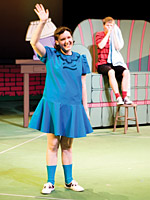Backstage With Bonnie
 By Clint Kelly
By Clint Kelly
This article originally appeared in Creators, SPU’s newsletter covering music, theatre, and the visual arts. Learn more at the Fine and Performing Arts website.
The debut of “Love Never Dies,” Andrew Lloyd Webber’s multi-million dollar sequel to “The Phantom of the Opera,” has overtaken the historic Adelphi Theatre in London’s West End.
Backstage, behind the innovative Coney Island sets, back where the imagination believes the Phantom lurks to again lure a now-married Christine to sing for him, a small army of stage magicians conjure the illusions that make audiences go wild over Webber’s musicals. Within that army is a battalion of costumers, including 11 dressers assigned to the 32 actors to ensure that a multitude of costume changes happen flawlessly.
One of those dressers is Bonnie Prather, a 2007 graduate of Seattle Pacific University’s theatre program. A professional costumer at age 24 in one of the world meccas of live theatre, Prather heaps the credit for her good fortune onto the shoulders of the theatre faculty at SPU.
Skills, Knowledge — and a Gentle Push
“As wardrobe manager my junior year and costume shop manager my senior year, I gained an amazing amount of knowledge in historical fashion, the technical skills to build them, and, above all, the confidence needed to pursue this job professionally,” she says. “And every morning, there was Professor Don Yanik to pester me with, ‘So, when are you applying to grad school?’”
She doesn’t think she would have gone without his prodding. With his support, she was accepted into the Arts University College at Bournemouth (England), where last year she received her master’s degree in costume design.
After graduation from Bournemouth, while living and job-hunting in London, she discovered that one of the wardrobe staff members on “Love Never Dies” was a friend. They had met during Prather’s week of work study on the production of “Les Miserables” at London’s Queen’s Theatre. She was recommended to Webber’s wardrobe manager and 15 minutes into the interview Prather was hired.
Little wonder she spent a while wandering about Covent Gardens “grinning like a madwoman.”
Sewing Buttons and Dressing Stars
Prather adds, “Pretty crazy to think that about six and a half years ago I was nervously interviewing for a position in the SPU costume shop mostly because I was terrified of the power tools in the tech shop. And pretty much unable to sew on a button!” Lucky for her, she not only learned how to attach buttons and make straight hems, but also how to drape and draft her own patterns, manage others, and design her own shows.
Because when the curtain rises on eight performances a week, she must follow a small number of actors throughout the show, and keep their costumes and accessories organized. She’s there to help with back zippers, corset lacings, and shoes on the slower changes, but the quick changes she does herself. The actors race backstage where she waits with costumes equipped with time-saving devices like Velcro or snap closures, and shoes laced with elastic. When some of those changes last but 30 to 60 seconds, the pace borders on frantic.
She guarantees her actors are neat and tidy, no stray threads or lint, all buttons buttoned correctly, wigs on straight, before they race back onstage. Quick fixes? Because this is a dance show, there will be popping buttons and the unexpected holes in fabric, which she has learned to repair on the fly.
Reveling in Opportunities
“It just doesn’t happen that often, that an American comes in and gets hired for a London production,” says Yanik. “But Bonnie really found herself in theatre. She didn’t know a lot coming into the SPU program yet became one of the best managers I ever had.”
Prather says the opportunities at SPU helped her achieve in every way, including the 2006 study abroad quarter she spent in the British Isles. While studying Shakespeare and Virginia Woolf with English majors, she reveled in the theatrical world of Stratford-Upon-Avon and London itself. She left SPU having designed four major shows and assisted Yanik on the main stage productions of “Twelfth Night” and “The Runner Stumbles.”
And because Seattle is a theatre town, and SPU has extensive contacts in that community, she found real world experience dressing, stitching, and designing at a variety of union theatres, including the Seattle Children’s Theatre and the Seattle Shakespeare Company, and even for a production of “Dante’s Inferno” at the Museum of Glass.
“By the time I graduated,” she says, “I had an excellent resume already built. There were several job offers from many of the theatres, and in such a volatile job market.”


